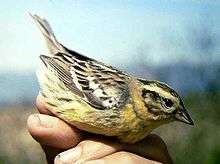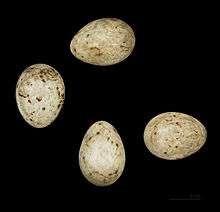Yellow-breasted bunting
| Yellow-breasted bunting | |
|---|---|
 | |
| Adult female | |
| Scientific classification | |
| Kingdom: | Animalia |
| Phylum: | Chordata |
| Class: | Aves |
| Order: | Passeriformes |
| Family: | Emberizidae |
| Genus: | Emberiza |
| Species: | E. aureola |
| Binomial name | |
| Emberiza aureola Pallas, 1773 | |

The yellow-breasted buntin (Emberiza aureola) is an Eurasian passerine bird in the bunting family (Emberizidae). The genus name Emberiza is from Old German Embritz, a bunting. The specific aureola is Latin for "golden".[2] The birds presents in the home is thought to be linked to "happiness". The bird also has a call that's a distinctive zick, and the song is a clear tru-tru, tri-tri.
Until 2004, the International Union for the Conservation of Nature considered the yellow-breasted bunting to be a species of least concern. In 2004, its status was changed to near threatened, and four years later it was uplisted again — to vulnerable — after new research has shown it to be rarer than had been believed. It is subject to heavy hunting pressure in China, through which most specimens pass during migration.[3] In 2013, its assessment changed to endangered,[4] and continues to decline.
Physical Characteristics
This bird is similar in size to a reed bunting, but longer-billed. The breeding male has bright yellow underparts with black flank streaks, brown upperparts, black face and throat bar, and a pink lower mandible.
The female has a heavily streaked grey-brown back, and less intensely yellow underparts. She has a whitish face with dark crown, eye and cheek stripes. The juvenile is similar, but the background colour of the underparts and face is buff.
Mating Behaviors
The call is a distinctive zick, and the song is a clear tru-tru, tri-tri.
The postures that are mainly focusesd on when relating them to mating behaviors are:
Wing raising
Held for a while by both sexes, at high intensity, one wing is fully extended and raised vertically. This mating behavior is mainly observed in males. At low intensity, the wing is not fully raised usually. But in some cases both wings are raised mutually, but not in a certain, equal rhythm. During the time one wing is being raised, the other is folded to the side of the body, this is referred to as reciprocal wing raising.
Tail fanning- walk
Almost touching the tip of the tail on the ground, it is spread wide and slightly drooped. Along with prominent wing-raising, trailing(wings slightly lifted from side of body and tips kept below the normal resting position), or drooping(slightly stretched wings). Feathers of head head always fluffed and body variation from slightly lowered to horizontal. Posture movement occurs normally when male tries to mate with female.
Ordinary Approach
This behavior turning into the tail-finning walk. The ordinary approach refers to a slightly lower body incline, with a closed tail the bird walks around or toward mate. Tail sometimes elevated this behavior is usually seen in females one wing is fully extended or raised partially upward.
Tailing Pulling
When observing this mating behavior, the mail goes behind his mate and pulls her tail repeatedly.
Crouching
Male crouches on ground, with head slightly high, legs flexed, neck retracted, with closed tail, while his rump or hind body is lowered.
Reproduction and Lifestyle
It breeds in north-eastern Europe and across northern Asia. It is migratory, wintering in south-east Asia, India, and southern China. It is a rare but regular wanderer to western Europe.
The yellow-breasted bunting breeds in open scrubby areas that consist of dry water rice fields for foraging and reedbeds for roosting, often near water, and is present in Siberia. It lays four to six eggs in a nest on the ground. Its food consists of insects when feeding young, and otherwise seeds.
Threats
The decline of the Yellow-breasted bunting is likely to be from repeatedly trapping at migration, and most specifically winter sites. The birds habitat is disturbed, then caught in mist-nets. They are then cooked and sold as "sparrows" or "rice birds". Even thoguh the actions have been restricted to a small area in southern China, it has became more widespread and popular to increasing wealth, and hunters now travel long distances to find sufficient birds. The irrigation of rice production shift has reduced the quality and quantity of wintering habitats, including the loss of water stubble. And the loss of reedbeds has reduced the available roost site numbers.
References
BirdLife International. 2013. Emberiza aureola. The IUCN Red List of Threatened Species 2013: e.T22720966A49004426. http://dx.doi.org/10.2305/IUCN.UK.2013-2.RLTS.T22720966A49004426.en. Downloaded on 05 December 2016.
Footnotes
- ↑ BirdLife International (2013). "Emberiza aureola". IUCN Red List of Threatened Species. Version 2013.2. International Union for Conservation of Nature. Retrieved 26 November 2013.
- ↑ Jobling, James A. (2010). The Helm Dictionary of Scientific Bird Names. London, United Kingdom: Christopher Helm. pp. 62, 145. ISBN 978-1-4081-2501-4.
- ↑ "abundant bird species could be wiped out like passenger pigeons". Retrieved 9 June 2015.
- ↑ "Yellow-breasted Bunting Emberiza aureola". BirdLife International. Retrieved 11 December 2014.
External links
- OBC 24 photographs (see pulldown menu at page bottom)
